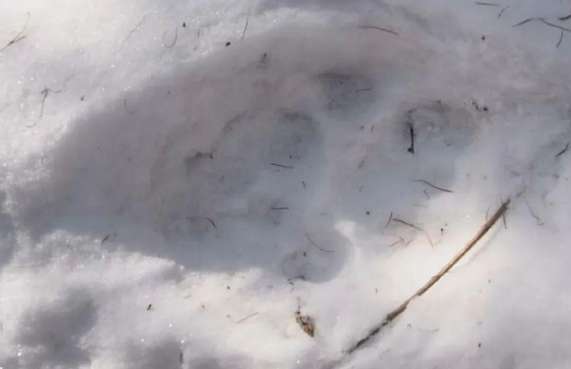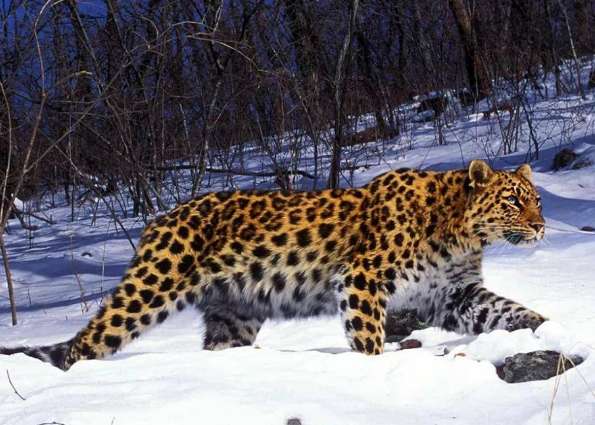Jilin Tianqiaoling Forest Area is an area with a relatively superior ecological environment in Northeast China and is rich in wild animal resources. Tigers and leopards often appear here. For example, since December 2022, people have repeatedly discovered traces of Siberian tigers and Siberian leopards in the Tianqiaoling forest area.
In order to better protect wild animals and create a safe living environment for them, the Tianqiaoling Forestry Bureau and other departments launched a large-scale mountain clearing operation.
Recently, when patrol personnel were cleaning up the junction of forest and land, they suddenly discovered a string of tracks left by big cats. After measuring and comparing the tracks, it was finally confirmed that they were an adult cat. Left behind by the Siberian leopard.
 < /p>
< /p>
The tracks lead directly to the dense forest. The patrolmen continued to explore along the tracks and gradually discovered the traces left by the Amur leopards for hunting and eating.
Judging from the large number of traces left at the scene, the staff determined that the Amur leopard had captured a roe deer and then ate it in the snow. The staff found some roe deer remains near the Amur leopard's feeding ground, including heads, hooves, hair, etc.
Continuing to follow the footsteps, the next scene surprised the rangers. After eating, the Amur leopard did not stay in the dense forest, but wandered near the residential area and wandered for a while. Then he left. Fortunately, there was no danger and the leopard did not attack anyone.
 < /p>
< /p>
The Amur leopard is one of the four species of leopards in China, also called the Amur leopard. The number is very rare. According to data from the Amur Tiger and Leopard National Park Administration in 2021, the number of wild Amur leopards in our country is 60. , an increase of about 42% compared to 2017.
The Amur leopard is medium in size. Among all cats in the northern cold zone, its size is second only to the Siberian tiger. It weighs 25-48 kg in adulthood.of a large predator.
The Amur leopard has a very good appearance. The hair on its body is beautiful golden yellow in spring and summer, but in winter, the hair color becomes lighter and grayer.
Leopards are one of the most successful cats, with a wide distribution range, ranging from the forests and snowfields of the Northeast, to the tropical rainforests of Southeast Asia, and to the savannas of Africa.
Leopards have superb hunting skills. They can climb trees and swim. They are famous for their wide-ranging diet. Their food consists of things that fly in the sky, things that run on the ground, things that swim in the water, ranging from small and medium-sized to large and hoofed. Animals are almost all leopards’ prey. However, relatively speaking, as a large predator, they prefer to prey on medium and large prey.
 < /p>
< /p>
A study based on 13 countries found that leopards preferentially prey on prey in the weight range of 10-40 kilograms. Roe deer is a medium-to-large cervid animal with an average weight of about 30 kilograms, which happens to be within the priority prey range of the Amur leopard.
When it comes to leopards eating, many people’s first reaction may be that they drag their prey into trees and then eat it slowly. This is indeed the case. Leopards are cats that are extremely good at climbing trees. After capturing their prey, in most cases they will drag the prey to the tree before eating. The purpose of this is to prevent the food from being eaten by other animals. Robbed by powerful predators.
Leopards are very powerful and can easily drag a 40 kilogram antelope up a tree. However, this situation mostly occurs in areas with high survival pressure, such as the African savanna. In addition to leopards, there are also powerful predators such as spotted hyenas and lions. Therefore, the leopards here will most of the time. Drag prey up trees before eating.
The Northeast region is vast and sparsely populated, and it is a similar situation for large predators. Although the area is famous for the presence of tigers and leopards, if you analyze it carefully, you will find that although the habitats of Siberian leopards and Siberian tigers overlap, Siberian leopards are mainly concentrated near the eastern mountains, and most of them avoid the activity range of Siberian tigers.
In addition, leopards are known as the "two kings" in our country, that is, in the forest ecosystem, their ecological niche is second only to tigers, and they are the second largest beast.
The number of Siberian tigers in our country is rare and their average range of activities is large. Therefore, the Siberian leopards living here do not need to worry too much about being robbed of food. At the same time, they also face less "scavenger" pressure, so they are less likely to need to spend extra moneyIt has become normal for them to drag their prey up the tree and eat it on the spot in the snow.
Judging from the footprints of Amur leopards found near residential areas, it shows that the activity space of Amur leopards in the Tianqiaoling forest area has overlapped with human activity areas. This requires people to be more vigilant, especially pay attention Don’t let the leopard’s sense of unfamiliarity with humans wear off.
An earlier survey based on leopard habitats across the country showed that leopard populations across the country are showing a recovery trend, and the number of Siberian leopards has also increased from 42 at the beginning of the Siberian Tiger and Leopard National Park pilot program in 2017. , the number increased to more than 60.
I believe that in the future, when the ecological environment is further improved and the results of animal protection are gradually revealed, the number of Amur leopards will continue to increase. Relatively speaking, the probability of people encountering them will also increase.
It is very necessary for people to maintain a sense of alienation from large beasts. In this regard, we might as well take a look at the situation in India. India is a country of tigers and leopards. Leopards are abundant and people often encounter them. Even in big Indian cities like Mumbai, when night falls, leopards will quietly sneak into the streets to prey on stray dogs.
Because there are so many leopards in India, they often break into villages to prey on livestock. As time goes by, the sense of strangeness towards humans disappears, and they find that humans move slowly, so incidents of leopard attacks on humans often occur in India.
In addition, some studies on man-eating tigers in the Sundarbans mangroves have found that people here often enter the mangroves to work, and the tigers inside have lost their sense of strangeness towards people, so they often prey on humans.
Maintain a sense of strangeness, let people feel awe of beasts, and let beasts feel awe of humans. This will benefit both parties. So when we witness Amur leopards or Siberian tigers, we should not disturb them, but choose to leave as soon as possible.
At the same time, try not to graze in areas where tigers and leopards roam, because past surveys and studies on Asian lions have found that human grazing will have a greater impact on the predators’ diet, making them more inclined to prey. livestock.